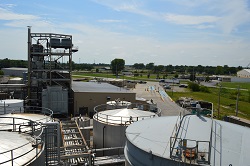Gevo’s plant in Luverne, Minnesota is now co-producing isobutanol and ethanol with one fermenter dedicated to isobutanol production and three fermenters dedicated to ethanol production. With the completion of the last phase of capital for SBS, Gevo has begun to produce and ship isobutanol in railcar volumes.
This equipment facilitates the extraction of isobutanol from the plant, which should enable Gevo to boost production levels of isobutanol by debottlenecking the downstream side of the plant. This distillation equipment was commissioned in early September and is already showing improved results at the plant, such as:
- A doubling of isobutanol batch sizes;
- A 50% reduction in isobutanol batch turnaround times;
- Consistent yields of >90% based on starch content; and
- A continued decrease in isobutanol production costs towards targeted
economic rates.
“We are on track with the SBS. We completed the installation of our isobutanol distillation column and it operates well. We are continuing to boost isobutanol production levels while simultaneously driving cost out of our production processes. We are pleased to be shipping both ethanol and isobutanol in railcar quantities. This isobutanol is destined for the solvents and specialty gasoline blendstock markets, as well as to supply our demo plant in Silsbee, TX, to convert our isobutanol into hydrocarbons such as bio-jet fuel and isooctane,” said Dr. Patrick Gruber, Gevo’s CEO.
Gruber continued, “By installing the last phase of capital at Luverne, we remain confident that we will be able to achieve production levels of 50-100 thousand gallons of isobutanol per month by the end of 2014. As we continue to learn and optimize the isobutanol production process, we believe we can ultimately increase our production rate to approximately 2-3 million gallons of isobutanol per annum under the SBS, while we are producing ethanol in the other three fermenters.”








